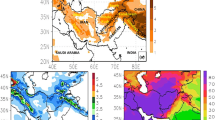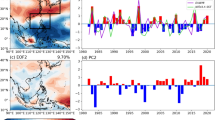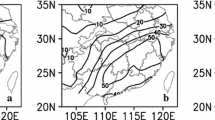Abstract
The seasonal cycle of the intraseasonal (IS) variability of precipitation in South America is described through the analysis of bandpass filtered outgoing longwave radiation (OLR) anomalies. The analysis is discriminated between short (10–30 days) and long (30–90 days) intraseasonal timescales. The seasonal cycle of the 30–90-day IS variability can be well described by the activity of first leading pattern (EOF1) computed separately for the wet season (October–April) and the dry season (May–September). In agreement with previous works, the EOF1 spatial distribution during the wet season is that of a dipole with centers of actions in the South Atlantic Convergence Zone (SACZ) and southeastern South America (SESA), while during the dry season, only the last center is discernible. In both seasons, the pattern is highly influenced by the activity of the Madden–Julian Oscillation (MJO). Moreover, EOF1 is related with a tropical zonal-wavenumber-1 structure superposed with coherent wave trains extended along the South Pacific during the wet season, while during the dry season the wavenumber-1 structure is not observed. The 10–30-day IS variability of OLR in South America can be well represented by the activity of the EOF1 computed through considering all seasons together, a dipole but with the stronger center located over SESA. While the convection activity at the tropical band does not seem to influence its activity, there are evidences that the atmospheric variability at subtropical-extratropical regions might have a role. Subpolar wavetrains are observed in the Pacific throughout the year and less intense during DJF, while a path of wave energy dispersion along a subtropical wavetrain also characterizes the other seasons. Further work is needed to identify the sources of the 10–30-day-IS variability in South America.






Similar content being viewed by others
References
Alvarez MS, Vera CS, Kiladis GN, Liebmann B (2014) Intraseasonal variability in South America during the cold season. Clim Dyn 42(11):3253–3269. https://doi.org/10.1007/s00382-013-1872-z
Alvarez MS, Vera CS, Kiladis GN, Liebmann B (2016) Influence of the Madden Julian Oscillation on precipitation and surface air temperature in South America. Clim Dyn 46(1):245–262. https://doi.org/10.1007/s00382-015-2581-6
Blázquez J, Solman SA (2016) Intraseasonal variability of wintertime frontal activity and its relationship with precipitation anomalies in the vicinity of South America. Clim Dyn 46(7):2327–2336. https://doi.org/10.1007/s00382-015-2704-0
Casarin D, Kousky V (1986) Precipitation anomalies in the southern part of brazil and variations of the atmospheric circulation. Rev Bras Meteor 1:83–90
Cerne SB, Vera CS (2011) Influence of the intraseasonal variability on heat waves in subtropical South America. Clim Dyn 36(11):2265–2277. https://doi.org/10.1007/s00382-010-0812-4
Duchon CE (1979) Lanczos filtering in one and two dimensions. J Appl Meteorol 18(8):1016–1022. https://doi.org/10.1175/1520-0450(1979)018<1016:LFIOAT>2.0.CO;2
Gonzalez PLM, Vera CS (2014) Summer precipitation variability over South America on long and short intraseasonal timescales. Clim Dyn 43(7):1993–2007. https://doi.org/10.1007/s00382-013-2023-2
González PLM, Vera CS, Liebmann B, Kiladis G (2008) Intraseasonal variability in subtropical South America as depicted by precipitation data. Clim Dyn 30(7):727–744. https://doi.org/10.1007/s00382-007-0319-9
Grimm AM, Dias PLS (1995) Analysis of tropical-extratropical interactions with influence functions of a barotropic model. J Atmos Sci 52(20):3538–3555. https://doi.org/10.1175/1520-0469(1995)052<3538:AOTIWI>2.0.CO;2
Hirata FE, Grimm AM (2016) The role of synoptic and intraseasonal anomalies in the life cycle of summer rainfall extremes over South America. Clim Dyn 46(9):3041–3055. https://doi.org/10.1007/s00382-015-2751-6
Hirata FE, Grimm AM (2016) The role of synoptic and intraseasonal anomalies on the life cycle of rainfall extremes over South America: non-summer conditions. Clim Dyn. https://doi.org/10.1007/s00382-016-3344-8.
Kalnay E, Kanamitsu M, Kistler R, Collins W, Deaven D, Gandin L, Iredell M, Saha S, White G, Woollen J, Zhu Y, Leetmaa A, Reynolds R, Chelliah M, Ebisuzaki W, Higgins W, Janowiak J, Mo KC, Ropelewski C, Wang J, Jenne R, Joseph D (1996) The ncep/ncar 40-year reanalysis project. Bull Am Meteorol Soc 77(3):437–471. https://doi.org/10.1175/1520-0477(1996)077<0437:TNYRP>2.0.CO;2
Li ZX, Le Treut H (1999) Transient behavior of the meridional moisture transport across South America and its relation to atmospheric circulation patterns. Geophys Res Lett 26(10):1409–1412
Liebmann B, Mechoso CR (2011) The South American Monsoon System. The global monsoon system. In: Chang C-P, Ding Y, Lau N-C (eds) The global monsoon system: research and forecast, 2nd edn. World Scientific Publication Company, Singapore, pp 137–157
Liebmann B, Smith CA (1996) Description of a complete (interpolated) outgoing longwave radiation dataset. Bull Am Meteorol Soc 77:1275–1277
Liebmann B, Vera CS, Carvalho LMV, Camilloni IA, Hoerling MP, Allured D, Barros VR, Baez J, Bidegain M (2004) An observed trend in central South American precipitation. J Clim 17(22):4357–4367. https://doi.org/10.1175/3205.1
Madden RA, Julian PR (1994) Observations of the 40–50-day tropical oscillation: a review. Mon Weather Rev 122(5):814–837. https://doi.org/10.1175/1520-0493(1994)122<0814:OOTDTO>2.0.CO;2
Mo KC, Paegle JN (2001) The pacific-South American modes and their downstream effects. Int J Climatol 21(10):1211–1229
North G, Bell T, Cahalan R, Moeng F (1982) Sampling errors in the estimation of empirical orthogonal functions. Mon Weather Rev 110:699–706
Paegle JN, Byerle LA, Mo KC (2000) Intraseasonal modulation of South American summer precipitation. Mon Weather Rev 128(3):837–850. https://doi.org/10.1175/1520-0493(2000)128<0837:IMOSAS>2.0.CO;2
Raupp CFM, Dias PLS, Tabak EG, Milewski P (2008) Resonant wave interactions in the equatorial waveguide. J Atmos Sci 65(11):3398–3418. https://doi.org/10.1175/2008JAS2387.1
Raupp CFM, Silva Dias PL (2010) Interaction of equatorial waves through resonance with the diurnal cycle of tropical heating. Tellus A 62(5):706–718
Reboita MS, Nieto R, Gimeno L, da Rocha RP, Ambrizzi T, Garreaud R, Krüger LF (2010) Climatological features of cutoff low systems in the southern hemisphere. J Geophys Res Atmos 115:D17104
Renwick JA (2005) Persistent positive anomalies in the southern hemisphere circulation. Mon Weather Rev 133(4):977–988. https://doi.org/10.1175/MWR2900.1
Schubert S, Park CK (1991) Low-frequency intraseasonal tropical–extratropical interactions. J Atmos Sci 48:629–650
Solman SA, Orlanski I (2010) Subpolar high anomaly preconditioning precipitation over South America. J Atmos Sci 67(5):1526–1542. https://doi.org/10.1175/2009JAS3309.1
Vera C, Higgins W, Amador J, Ambrizzi T, Garreaud R, Gochis D, Gutzler D, Lettenmaier D, Marengo J, Mechoso CR, Nogues-Paegle J, Dias PLS, Zhang C (2006) Toward a unified view of the american monsoon systems. J Clim 19(20):4977–5000. https://doi.org/10.1175/JCLI3896.1
Vera CS, Vigliarolo PK, Berbery EH (2002) Cold season synoptic-scale waves over subtropical south america. Mon Weather Rev 130(3):684–699. https://doi.org/10.1175/1520-0493(2002)130<0684:CSSSWO>2.0.CO;2
Wheeler MC, Hendon HH (2004) An all-season real-time multivariate MJO index: development of an index for monitoring and prediction. Mon Weather Rev 132(8):1917–1932. https://doi.org/10.1175/1520-0493(2004)132<1917:AARMMI>2.0.CO;2
Wilks D (2011) Statistical methods in the atmospheric sciences. Academic Press, Oxford
Zhang C (2005) Madden–Julian Oscillation. Rev Geophys 43(2):RG2003
Acknowledgements
The research was supported by Consejo Nacional de Investigaciones Científicas y Técnicas (CONICET) PIP 112-20120100626CO, UBACyT 20020130100489BA, PIDDEF 2014/2017 Nro 15, Belmont Forum/ANR-15-JCL/-0002-01 “CLIMAX”. M.S.A. was supported by a Postdoctoral grant from CONICET, Argentina.
Author information
Authors and Affiliations
Corresponding author
Electronic supplementary material
Below is the link to the electronic supplementary material.
382_2017_3994_MOESM1_ESM.gif
Online Resource 1 (Left column) Maps of linear lagged regressions between OLR anomalies and the standardized PC1 30-90 for each season, for lags -30 to 0. The values enclosed by the black contour are significant. Units in Wm-2. (Right column) Local linear lagged regression between OLR anomalies and the standardized PC1 30-90 for each season, for lags -30 to 0, in Wm-2. The green (brown) line corresponds to a point within the SESA (SACZ) center of action. First three rows correspond to the wet season, divided in ON, DJF and MA. The fourth row corresponds to the dry season (GIFF 21,529 KB)
382_2017_3994_MOESM2_ESM.gif
Online Resource 2 (Left column) Maps of linear lagged regressions between 0.21 σ-level streamfunction anomalies and the standardized PC1 30-90 for each season, for lags -30 to 0. The values enclosed by the black contour are significant. Units in 10-5m2s-1. Vectors represent the linear lagged regression of the wave activity fluxes for the 0.21 σ-level. The reference magnitude is shown below the first map and its units are m2s2. (Right column) Local linear lagged regression between OLR anomalies and the standardized PC1 30-90 for each season, for lags -30 to 0, in Wm2. The green (brown) line corresponds to a point within the SESA (SACZ) center of action. First three rows correspond to the wet season, divided in ON, DJF and MA. The fourth row corresponds to the dry season (GIFF 19,994 KB)
382_2017_3994_MOESM3_ESM.gif
Online Resource 3 (Left column) Maps of linear lagged regressions between OLR anomalies and the standardized PC1 10-30 for each season, for lags -15 to 0. The values enclosed by the black contour are significant. Units in Wm-2. (Right column) Local linear lagged regression between OLR anomalies and the standardized PC1 10-30 for each season, for lags -15 to 0, in Wm-2. The green (brown) line corresponds to a point within the SESA (SACZ) center of action. From upper to lower row, SON, DJF, MAM and JJA (GIFF 9,104 KB)
382_2017_3994_MOESM4_ESM.gif
Online Resource 4 (Left column) Maps of linear lagged regressions between 0.21 σ-level streamfunction anomalies and the standardized PC1 10-30 for each season, for lags -15 to 0. The values enclosed by the black contour are significant. Units in 10-5m2s-1. Vectors represent the linear lagged regression of the wave activity fluxes for the 0.21 σ-level. The reference magnitude is shown below the first map and its units are m2s-2. (Right column) Local linear lagged regression between OLR anomalies and the standardized PC1 10-30 for each season, for lags -15 to 0, in Wm-2. The green (brown) line corresponds to a point within the SESA (SACZ) center of action. From upper to lower row, SON, DJF, MAM and JJA (GIFF 8,957 KB)
Rights and permissions
About this article
Cite this article
Vera, C.S., Alvarez, M.S., Gonzalez, P.L.M. et al. Seasonal cycle of precipitation variability in South America on intraseasonal timescales. Clim Dyn 51, 1991–2001 (2018). https://doi.org/10.1007/s00382-017-3994-1
Received:
Accepted:
Published:
Issue Date:
DOI: https://doi.org/10.1007/s00382-017-3994-1




